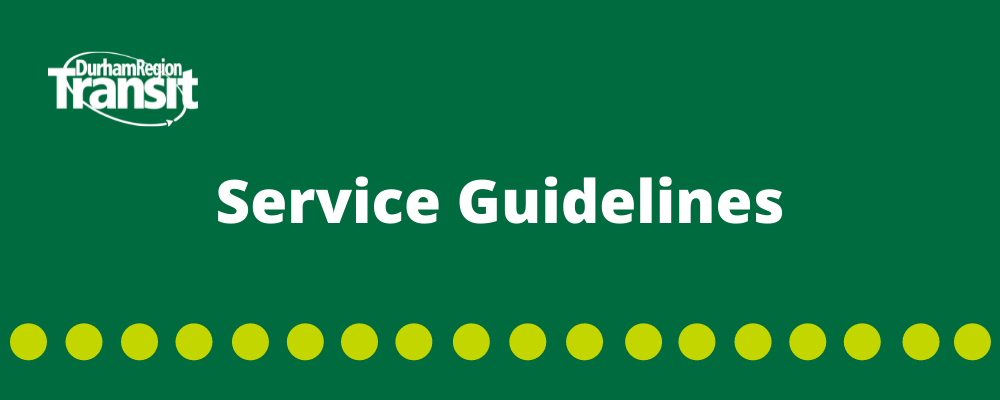| Service deployment | |||||||||||||||||||||||||||||||||||||||||||||||||||||||||||||||||||||||||||||||||||||||||||||||||||||||||||||||||||||||||||||||||||||||||||||||||||
|
Residents of Durham Region can access transit services throughout the entire area from early mornings to late night, seven days a week. How the service is delivered to an area varies by time of day and day of the week, to ensure that services are sustainable and implemented in an efficient and fair manner. The Demand Response delivery model provides base coverage in rural Durham Region and in urban areas when customer demand does not meet minimum ridership productivity for scheduled bus service. The following framework is used when considering transitioning an area to scheduled service from Demand Response:
|
|||||||||||||||||||||||||||||||||||||||||||||||||||||||||||||||||||||||||||||||||||||||||||||||||||||||||||||||||||||||||||||||||||||||||||||||||||
| Ridership productivity | |||||||||||||||||||||||||||||||||||||||||||||||||||||||||||||||||||||||||||||||||||||||||||||||||||||||||||||||||||||||||||||||||||||||||||||||||||
The ridership productivity guideline provides a measure of the effectiveness of a transit route. As a base service, Demand Response service is provided when scheduled routes are unable to meet minimum ridership productivity targets. Ridership productivity targets are not applicable to the overnight network, because the service provides mobility to groups of customers who may have no other travel option available. Each service type (PULSE, Base, GO Transit Connector and rural) contribute differently to the DRT transit network and each have unique minimum productivity targets. Route productivity varies based on the varying built environments in which each route operates. The following are used for each service type:
Table 1 provides ridership productivity minimums for each route type/classification. Table 1: Ridership productivity minimums for each scheduled service route type (boardings per hour)
|
|||||||||||||||||||||||||||||||||||||||||||||||||||||||||||||||||||||||||||||||||||||||||||||||||||||||||||||||||||||||||||||||||||||||||||||||||||
| Service frequency and span of service | |||||||||||||||||||||||||||||||||||||||||||||||||||||||||||||||||||||||||||||||||||||||||||||||||||||||||||||||||||||||||||||||||||||||||||||||||||
| DRT provides 24-hour transit service seven days a week in urban areas, and service from 06:00 to 24:00 on weekdays and 07:00 to 21:00 on weekends in rural areas. The span of service and service levels varies for each of the Demand Response zones and scheduled routes, based on customer demand. A scheduled route must meet the minimum ridership productivity guideline, which is based on the minimum service frequency at which it is required to operate.
Table 2 presents the minimum service levels for each scheduled route type. In many cases, routes may need to operate more frequently than the minimum frequencies to accommodate higher ridership levels. In these cases, vehicle capacity guidelines are used to determine the service frequency. Tables 2-4: Minimum service levels for each route type
On the scheduled service network, the minimum service frequency is 30 minutes on urban routes and 90 minutes on rural routes. This results in a customer waiting up to 15 minutes for a bus in the urban area, and 45 minutes in the rural area. To ensure equity to scheduled service wait times, DRT deploys vehicles to ensure the time between a customer requesting a Demand Response trip and pick up, achieves the following objectives:
By 2025, all Demand Response customers, including current Specialized Services customers, will experience similar average trip wait times, including pre-booked trips or trips scheduled in real time. The accommodated rate for trip requests made by eligible persons with disabilities will exceed 99.6 per cent. |
|||||||||||||||||||||||||||||||||||||||||||||||||||||||||||||||||||||||||||||||||||||||||||||||||||||||||||||||||||||||||||||||||||||||||||||||||||
| Vehicle capacity | |||||||||||||||||||||||||||||||||||||||||||||||||||||||||||||||||||||||||||||||||||||||||||||||||||||||||||||||||||||||||||||||||||||||||||||||||||
|
The vehicle capacity guidelines provide a level of customer comfort when travelling on DRT. The guideline is used when designing services; however the customer experience may vary due to unplanned operational issues and day-to-day variability in travel demand. These guidelines do not apply to the current vehicle loads implemented in response to the COVID-19 pandemic. The following guidelines are used when designing the service:
Vehicle capacity considers the average number of passengers that can be accommodated on a bus during its busiest hour, and most popular point on the route. |
|||||||||||||||||||||||||||||||||||||||||||||||||||||||||||||||||||||||||||||||||||||||||||||||||||||||||||||||||||||||||||||||||||||||||||||||||||
| Service proximity | |||||||||||||||||||||||||||||||||||||||||||||||||||||||||||||||||||||||||||||||||||||||||||||||||||||||||||||||||||||||||||||||||||||||||||||||||||
|
Service proximity means the walking distance between dwellings and the nearest bus stop. In the urban area, DRT aims to have:
In the rural area, 100 per cent of dwellings will be served by Demand Response at the curb (such as the entrance to a property). Customers who are eligible for Specialized Services are provided an accessible door-to-accessible-door trip, based on their eligibility. Customers with unconditional eligibility will receive trips using only Demand Response service. Customers with conditional eligibility may receive trips that include travel on a combination of Demand Response and scheduled service. |
|||||||||||||||||||||||||||||||||||||||||||||||||||||||||||||||||||||||||||||||||||||||||||||||||||||||||||||||||||||||||||||||||||||||||||||||||||
| PULSE rapid bus considerations | |||||||||||||||||||||||||||||||||||||||||||||||||||||||||||||||||||||||||||||||||||||||||||||||||||||||||||||||||||||||||||||||||||||||||||||||||||
|
Scheduled services will be considered to transition to the PULSE service type when the following criteria are met:
|

